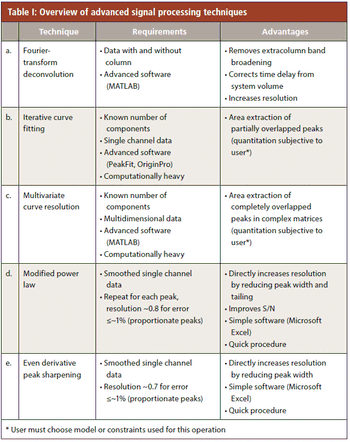Articles by M. Farooq Wahab

Separation scientists frequently encounter critical pairs that are difficult to separate in a complex mixture. To save time and expensive solvents, an effective alternative to conventional screening protocols or mathematical peak width reduction is called iterative curve fitting.

The advantages and limitations of several recently introduced mathematical procedures for enhancing peak resolution in liquid chromatography (LC) are described. Despite advanced separation technologies and extensive knowledge in method development, peak overlap is still commonly observed. This article gives a brief overview of the advantages and limitations of recently introduced mathematical procedures for enhancing resolution.

This article gives a brief overview of the advantages and limitations of recently introduced mathematical procedures such as the Fourier deconvolution of extracolumn effects, iterative curve fitting, multivariate curve resolution, modified power law, and use of first and second derivatives in enhancing resolution. High-throughput analyses in gas chromatography (GC), LC, and supercritical fluid chromatography (SFC) could benefit from these simple and effective approaches in many challenging separations applications.

We explore the developments that have made it possible to produce sub-minute, and, more recently, even sub-second enantiomeric separations. We also look at the questions that remain unanswered.

Compared to the progress made in reversed phase separations in terms of speed and efficiency, chiral chromatographers have traditionally focused on improving the selectivity of enantiomeric separations by synthetic procedures. As a result, more than 50 different types of advanced chiral stationary phase chemistries are available today. Traditionally, speed and efficiency of chiral chromatography has not received attention until recently. With the availability of superficially porous particles and sub-2-µm particles, sub-minute enantiomeric separations have been achieved with the help of improved particle technology with narrow size distribution, and systematic studies on packing columns. This article covers advances made in the field of ultrafast chiral chromatography in the last decade. The development of instrumentation technology has also contributed immensely to making sub-second chiral separations a reality. Enantiomeric separations can now compete with the speed of sensors. Future directions and unanswe

Despite the theoretical promise of reduced plate heights (h) < 1, most modern UHPLC columns can only deliver plate heights in the range from 1.4 to 2.5. However, improved packing procedures, a better understanding of the colloidal properties of particle suspensions, and the study of the rheological behavior of packed beds and the final bed structure should lead us to practical solutions that can double the column efficiencies.

Gaussian peak shapes in chromatography are indicative of a well-behaved system. Such peak shapes are highly desirable from the perspective of column packing technology. From an analyst’s point of view, Gaussian peaks provide improved sensitivity (lower detection limits) and allow ease of quantitation. In practice, one can obtain peaks that tail, front, or concurrently front and tail for reasons such as column packing issues, chemical and kinetic effects, and suboptimal high performance liquid chromatography (HPLC) system plumbing and detector settings. Here, we discuss a number of approaches for peak shape measurement that are available in modern chromatography software, along with their advantages and drawbacks. A new “total peak shape analysis” approach is suggested that facilitates detection and quantification of concurrent fronting and tailing in peaks. Several remediation approaches are proposed that can help chromatographers analyze and improve peak shapes.

A number of approaches for peak shape measurement are available in modern chromatography software. We discuss the advantages and drawbacks of those approaches, and present a new concept, “total peak shape analysis.”

The speed of IC has been limited by pressure and flow limits of the hardware. Recent advances are enabling faster IC separations.














